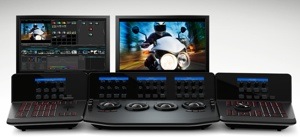Blackmagic Design (http://www.blackmagic-design.com/) has announced the availability of DaVinci Resolve 8, an update to the color correction tool.
New features in DaVinci Resolve 8 include multi-layer timeline support with editing, and XML import and export with Apple Final Cut Pro 7 and Adobe Premiere Pro. The new version includes OpenCL processing to allow use on an iMac and MacBook Pro computers.
New advanced processing tools have been added for real time noise reduction, curve grading, advanced multi point stabilization as well as automatic stereoscopic 3D image alignment. DaVinci Resolve 8 also supports the Avid Artist Color, Tangent Wave and JL Copper control panels plus offers ALE export to relink graded DNxHD files back into Avid editors.
The new XML import and export combined with the multi layer timeline lets complex sequences from Apple Final Cut Pro 7 and Adobe Premiere Pro to be imported, color graded and then exported directly back into Final Cut Pro 7 or Premiere Pro, with all the new graded shots, and the layer structure, intact. If the edit is changed, DaVinci Resolve 8 will automatically relink all the clips so the grades are preserved. Editing can also be performed inside DaVinci Resolve 8, and clips adjusted and relocated.
Advanced OpenCL image processing has been incorporated into DaVinci Resolve 8, and this allows a broader range of GPUs to be used for real time processing up to 1080 HD resolutions. OpenCL based processing, while not as powerful as CUDA processing also used on DaVinci Resolve, does allow a much wider range of computers that can be used for color grading. This allows iMac and MacBook Pro series computers can be used for real time grading, allowing customers to use the computer hardware they already have.
Often digital cameras when shooting in low light conditions will suffer from electrical noise in blacks, and film originated shots often include film grain and electronic noise from the film scanner. DaVinci Resolve 8 includes a new high quality CUDA noise reducer which eliminates noise and helps make images perfectly clean. Unlike any other solution, the DaVinci Resolve 8 noise reduction is incorporated into the color correctors, so it can be used in any corrector node and limited to inside or outside windows or by color qualifiers, so noise reduction can be used creatively by the colorist.
For handling shots that suffer from movement of the camera, DaVinci Resolve 8 includes a new multi point advanced stabilizer, which fixes unstable shots. The stabilizer is intelligent, and uses dozens of stabilization points to totally lock every part of the image.
For colorists who are new to DaVinci Resolve, there is now a new Curve Grading feature that works exactly the same way as low end editing software grading. DaVinci Resolve 8 Curve Grading takes this interface further as colorists can customize the curves and they get greater control with hue vs hue, hue vs sat, hue vs lum and lum vs sat controls. For fastest grading speed, curves can be adjusted from the mouse as well as the control panel.
For colorists working on stereoscopic 3D work, DaVinci Resolve 8 includes a new automatic image alignment tool that automatically aligns images between cameras to purportedly produce a “perfect” 3D image. 3D materiel is shot using two cameras combined with optics, and this causes problems with alignment because it’s impossible to perfectly align down to the pixel level two cameras mechanically.
With the new DaVinci Resolve 8 automatic stereoscopic 3D image alignment, hundreds of individual image points are analyzed and the image is aligned between eyes. This new 3D alignment uses image processing developed by the Blackmagic Design advanced algorithm team.
Blackmagic Design’s DaVinci Resolve is compatible with Mac OS X and Linux computers. It’s available starting from US$995 via Blackmagic Design resellers worldwide. All current Blackmagic Design DaVinci Resolve 7 customers can now download this update free of charge from the Blackmagic Design web site.




